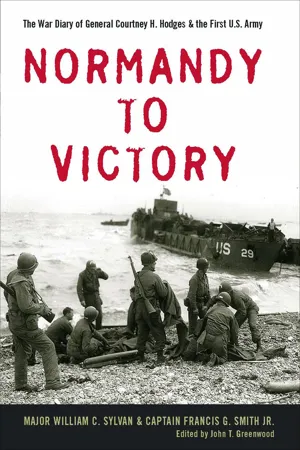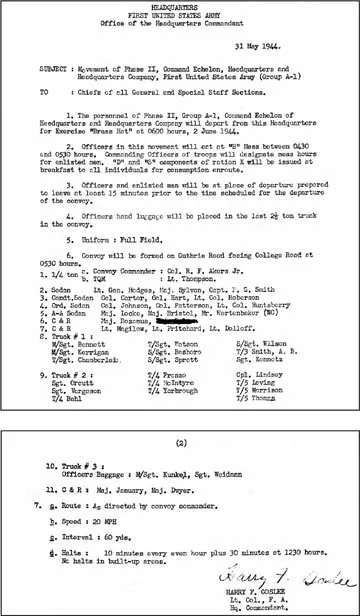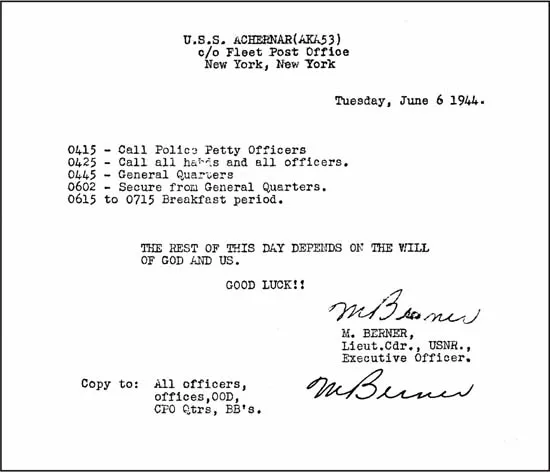![]()
Chapter 1
The Invasion of France and the
Lodgment in Normandy,
2 June–24 July 1944
Mounting the Invasion and Establishing the Beachhead,
2–10 June 1944
Friday, 2 June 1944: The General [Lt. Gen. Courtney Hicks Hodges], Bill [Capt. William E. Smith, aide), and I [Maj. William C. Sylvan, senior aide]1 left Bristol at 9 o’clock in the morning on exercise “Brass Hat”2 (see next page for inclosure). Passing thru Bridgewater and Exeter, we stopped briefly at noon for some sandwiches at the side of the road and then drove on to Plymouth, arriving at 1330. In a few minutes, an LCVP [Landing Craft, Vehicle and Personnel] took us to the Headquarters Ship—the USS Achenar [Achernar],3 13,000 tons of the A53 class, commissioned in February, 1944 and considered by officers and men alike as a “lucky” ship. No member of her crew had been hurt, she had met with no incident on her trip across and down from Gourock, Scotland, her engines had always kept whirring. Perhaps most remarkable of all, at least to the officers, was the fact that 85% of her crew had never been to sea before, and yet after three months were discharging their duties with considerable skill. The commander was R. F. [Cdr. H. R.] Stevens, Naval Academy, Class of 1922; the Executive [Officer] [Lt. Cdr. M. Berner] a jolly (but sometimes wrathful) W. C. Fields character who had been 22 years in the Merchant Marine and before assigned to the Achenar had had charge of a division of mine-sweepers under Admiral Ingraham [Ingram]4 in the South Atlantic.
The Operations Room, two decks below the hatch, was a small white-walled room most of which was reserved for the Air Corps, its plotting board and communications system on either side were two smaller rooms, likewise reserved for the Air Corps. The Navy personnel representing Rear Admiral [Alan G.] Kirk5 (headed by Captain E. A. Mitchell; Lt Commander Roger Putnam,6 ex-mayor of Springfield, Mass.; and Lt. Commander Oren Root, Jr.,7 the young New York lawyer who started the Willkie-for-President clubs throughout the country in 1940) were seated against one wall; the other wall went for an operations map, the third for various Army personnel; the table in the middle for the General, G-2 and G-3.8 The one newspaperman on board was Charles Wertenbaker,9 representing Time & Life.
May 31, 1944. The movement order from Headquarters, First U.S. Army, for Exercise Brass Hat.
In the evening the weather did not look promising. Ugly clouds were overhead, and there was a swift little chop to the waves, though we were anchored far inside the inner harbour, along with countless LCTs [Landing Craft, Tank] and mine-sweepers, all flying the American flag.
Saturday, 3 June 1944: The General conferred in the Ops Room with the staff headed by Colonel Ed. Johnson10 AGF [Army Ground Forces],11 TD [temporary duty] with First Army, and Colonel [Russell F.] Akers,12 G-3. At 1430 General Bradley,13 General [William B.] Kean,14 the four G’s, and Chief of Staff 15 to Admiral Kirk [Rear Adm. Arthur D. Struble] were piped aboard for a brief visit. At 1640 the Mayfield [U.S.S. Bayfield],16 flagship for the VII Corps, passed us, followed by a steady stream of LCIs [Landing Craft, Infantry] and LSTs [Landing Ship, Tank], and by 12 mine-sweepers. The weather seemed promising for The Day. The General spent the evening in the war room. Just before retiring for bed, Colonel [W. C.] Roberson,17 G-2, brought the message that the ships radio monitor had picked up, from the OWI [Office of War Information] station WRUX in New York, the report that the Associated Press had announced, in word from General [Dwight D.] Eisenhower’s18 headquarters,19 the beginning of the invasion. This was followed by an urgent “Kill Story, Kill.” We discussed briefly who could be responsible for such a dangerous, irresponsible blunder.
Sunday, 4 June 1944: Tomorrow is the day, and the harbour is deserted. It is a chilly day, with grey clouds passing low but with little real wind. But at breakfast we learn the bad news; at 5 AM the General had been awakened with notice of postponement because of unfavorable weather. General Kean, Colonel [Truman C.] Thorsen [Thorson],20 and Colonel [Benjamin A.] Dickson21 arrive for a conference in the morning, and at 1135 General [Omar N.] Bradley and General [Ralph] Royce,22 also with General Kean and Colonel Thorsen. At 1500 the General goes ashore to Admiral [Don P.] Moon’s23 headquarters for another conference with American and British leaders. At 1715 that evening the harbour is filling up again with boats turned back from their mission. The General returns with the news that, given good weather, the invasion could take place any day between now and Friday, 9 June, but that if postponed beyond that, another two weeks would have to pass before the tides would be favorable.
Late that evening we learn that the meteorologists now say everything will be all right, so the show is on again. In the west, at 2300, the sky is still cold and clear.
Monday, 5 June 1944: General Kean and Colonel Thorson came aboard at 0930 for a last-minute settlement of plans with the General. A little later the Augusta, famous cruiser which is Admiral Kirk’s flagship and on which General Bradley, General Kean and the four G’s are travelling lifts anchor, and at 12 two tugs push and guide us down to the entrance of the harbour, where we drop again. At 1550 the Augusta slides through the narrow breakwater passage, followed by two British cruisers and dozens of LSIs [Landing Ship, Infantry], all tossing little sausage balloons in the air. To our left a coastal battery fires on a towed target—this seems a strange time for British coastal batteries to be practicing, and to our right giant Sunderlands [Sunderland] flying boats24 start on their routine anti-sub patrols. At 1800 the General says that the weather report is the best thus far received; to be honest, it looks none too good. There are angry clouds in the sky and the sea is commencing to boil.
At 2100 we listen to the BBC announce the fall of Rome [4 June 1944] and the wild scenes of celebration with which the Allied armies were greeted. We celebrate by putting our operations map up in the War Room. Everything is ready to go. The Achenar starts on her adventure on the dot of midnight, escorted by two American destroyers. In the words of Commander Bermer [Berner] (see incl. #2), “The rest depends on us and the will of God.”
Tuesday, 6 June 1944: At 0800 there are still no reports. There is blue in the sky above and the sun is out but there is a strong breeze blowing, and our procession of LCIs, marching in two columns behind us, dip and toss in the whitecaps. Also in the procession is a lumbering LSD, Landing Ship Dock, which can accommodate a half dozen smaller craft in its innards and repair them. Ahead of us our two destroyers proceed carefully through the mine-swept designated channels past flagged buoys; overhead are Thunderbolts [P-47s]25 and a mission of 36 B-26s,26 returning from a job done in France.
At 0930, exactly as promised, we hear the first communique over the radio, very vague, as was to be expected, stating only that landings are being made on the north coast of France. At 0945 General Eisenhower broadcasts his message; telling the people of France to act only if they have received definite orders to act, and assuring the peoples of other occupied countries that their day will come. He was followed by King Haakon of Norway and other United Nations leaders. At 1030 we slow down to six knots as we approach a huge convoy ahead. “Now is sub time, if ever,” says the Chief Engineer [Col. William A. Carter Jr.].27 It is a beautiful warm day, but getting rougher every minute.
June 6, 1944. Lt. Cdr. Berner’s order of the day.
By 1215 we have two convoys on our left—convoys which stretch as far as the eye can reach, every ship flying his barrage balloon, the sole means of determining how large the convoy actually is, for with the glasses, the balloons can be counted. There are 100 in one convoy.
By 1300 we can sight land—a thin purple haze some twenty or twenty five miles away. At 1400 we pass the Augusta, and an hour later reach the transport area, some 12 miles off shore. At 2000 we take aboard the first wounded—an officer from the 1st Division, and later on, several enlisted men. The waves are so high it took an hour to land one from an LCI in a stretchers buoy. Early reports from land are none too encouraging, and when before 2100 the Achenar moves to within four miles of Omaha Beach.28 The angry flashes of fire from the cliffs above is clearly visible without the use of glasses. The American battleships, the Texas, Nevada, and Arkansas; the French cruisers Montcalm and Georges Legues [Leygues]; the British cruiser, Enterprise, and numerous destroyers of all nations are laying in a murderous fire, both on top of the cliffs and in the enemy’s rear, and the town of Port en-Bessin, which marks the boundary between the First Army and Second British Army, is ablaze in several spots.
One of the first reports of V Corps ends: “God bless the American Navy.” Our crew has been on General Quarters most of the day, and are called out again at 2200. We have our first air-raid; every ship is having a trial with its guns, and the story is that we have accounted for three Boche.29 Nothing drops close.
The situation at midnight was as follows: Omaha Beach, from which original reports had been very pessimistic, is improving, with the 16th Infantry [1st Infantry Division] reported at Colleville-Sur-Mere [Colleville-sur-Mer]; the 116th [29th Infantry Division, then attached to the 1st Infantry Division] at St. Laurent [St. Laurent-sur-Mer]. The 1st Division had set up its CP [Command Post], and at 2030, V Corps had gone ashore.
Utah Beach,30 12th Infantry at Les Forges. 4th [Infantry Division] CP set up. Still no positive contact made, however, with the 82nd and 101st Airborne Divisions, which had been dropped behind the beach, starting at 0001, D Day. However, gliders are coming in, against no visible AA [antiaircraft] fire, and the situation looks promising.
Wednesday, 7 June 1944: It is murky and cloudy, a 2,000-ft ceiling which as the morning progresses, opens up. The sea is still choppy, and very little seems to be getting into the beach. Major Dwyer and Colonel [Walter A.] Huntsberry [G-4 Section]31 go into Omaha Beach, and Colonel [Charles. G.] Patterson [chief, Antiaircraft Artillery Section]32 and Major [D. L.] Bristol [Artillery Section] to Utah to see if they can obtain more definite information; communications are slow and erratic. The report from Omaha was that a German division, had moved into the Omaha area on an exercise the night before the invasion, and that consequently the First Division had found itself up against four German regiments. Colonel Huntsberry said the dead of both sides had been pretty well cleared away; the First Division and V Corps both have their CPs set up, close together, and only a mile off the beach, on the side of the road off Easy-Red,33 up which whatever traffic that is unloaded seems to be moving. There is some shelling of the beach going on; General [William M.] Hoge34 has been slightly wounded; the Rangers are having a very tough time around Pointe de Hoe [Pointe du Hoc] and Grandcamp [Grandcamp-les-Bains], with casualties high and ammunition running low. Snipers and machine guns are still placing fire on the beaches, and sporadic artillery fire is also landing.
Much artillery has been lost in landing, and the beach is so crowded with wrecked or disabled craft that unloading is a terrific problem. Junction has been made between the 101st Division and the 4th, but the situation of the 82nd is still obscure. Contact has been made between the Rangers and the 29th Division at St. Pierre-de-Mond [St. Pierre-du-Mont]; and the 2nd Division was beginning, late in the afternoon, to unload. By 2400, the schedule of unloading was exactly one tide behind.
The report from Utah appears very satisfactory. Opposition to the landing was light, the 4th has pushed well inland, and the Corps CP is set up. This news was quite surprising to some, as it had been generally estimated that Omaha was the easier of the two beaches to conquer.
At 2030 General Hodges, accompanied by Colonel Akers [G-3 Section] and Lt Colonel Huntsberry visit V Corps Headquarters, returning at 2400. The situation seems slightly improved.
We have another sharp air-raid after 1330, and intermittent attacks throughout the night. A far greater show of strength from the German Air Force had been expected; these raids appear to be made by groups of two or three aircraft.
Thursday, 8 Jun...



